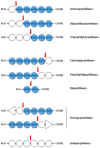Characteristics of the Proteolytic Enzymes Produced by Lactic Acid Bacteria
- PMID: 33806095
- PMCID: PMC8037685
- DOI: 10.3390/molecules26071858
Characteristics of the Proteolytic Enzymes Produced by Lactic Acid Bacteria
Abstract
Over the past several decades, we have observed a very rapid development in the biotechnological use of lactic acid bacteria (LAB) in various branches of the food industry. All such areas of activity of these bacteria are very important and promise enormous economic and industrial successes. LAB are a numerous group of microorganisms that have the ability to ferment sugars into lactic acid and to produce proteolytic enzymes. LAB proteolytic enzymes play an important role in supplying cells with the nitrogen compounds necessary for their growth. Their nutritional requirements in this regard are very high. Lactic acid bacteria require many free amino acids to grow. The available amount of such compounds in the natural environment is usually small, hence the main function of these enzymes is the hydrolysis of proteins to components absorbed by bacterial cells. Enzymes are synthesized inside bacterial cells and are mostly secreted outside the cell. This type of proteinase remains linked to the cell wall structure by covalent bonds. Thanks to advances in enzymology, it is possible to obtain and design new enzymes and their preparations that can be widely used in various biotechnological processes. This article characterizes the proteolytic activity, describes LAB nitrogen metabolism and details the characteristics of the peptide transport system. Potential applications of proteolytic enzymes in many industries are also presented, including the food industry.
Keywords: lactic acid bacteria; proteolysis; proteolytic enzymes.
Conflict of interest statement
The authors declare no conflict of interest.
Figures



References
-
- Abd Latip M.A., Abdul Hamid A.A., Nordin N.F.H. Microbial hydrolytic enzymes: In silico studies between polar and tropical regions. Polar Sci. 2019;20:9–18. doi: 10.1016/j.polar.2019.04.003. - DOI
-
- Kenny O., FitzGerald R.J., O’Cuinn G., Beresford T., Jordan K. Growth phase and growth medium effects on the peptidase activities of Lactobacillus helveticus. Int. Dairy J. 2003;13:509–516. doi: 10.1016/S0958-6946(03)00073-6. - DOI
Publication types
MeSH terms
Substances
LinkOut - more resources
Full Text Sources
Other Literature Sources
Miscellaneous

